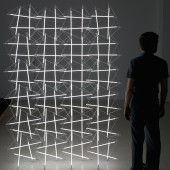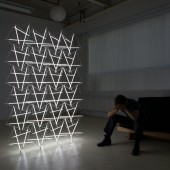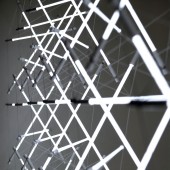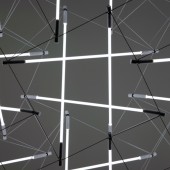Tensegrity Space Frame Light Lighting Structure by Michal Maciej Bartosik |
Home > Winners > #33658 |
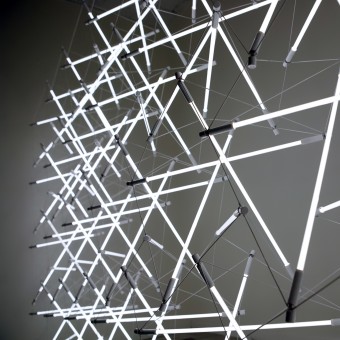 |
|
||||
| DESIGN DETAILS | |||||
| DESIGN NAME: Tensegrity Space Frame Light PRIMARY FUNCTION: Lighting Structure INSPIRATION: Although it was Snelson who pioneered floating compression, without Fuller's technological prowess and industrialist ambitions, tensegrity would have remained obscured from the world as the mere subject of an artistic practice. My desire to combine light with tensegrity was a means to reconcile Snelson with Fuller. In this way, to put light in compression elevates Snelson's sleigh of hand to a level having higher stakes, while the material fragility of the glass lamp in compression resonates with a Fullerian structural purity. UNIQUE PROPERTIES / PROJECT DESCRIPTION: The tensegrity space frame light eliminates previous redundancies between light and structure in order to produce luminous form. Utilizing Snelson's structural discovery, appropriated and popularized by Buckminster Fuller as tensegrity, the light source and its electrical wire work mutually in compression and tension to produce a seemingly discontinuous field of light defined only by its inherent and modular structural logic. OPERATION / FLOW / INTERACTION: The tensegrity space frame light suggests new possibilities for a marriage between structure and lighting. Its scalability, and the economy of its production speak to a commodity of endless configuration and use whose ephemeral qualities of light allude to spaces and volumes not yet fully determined. Visually didactic, its luminous form lays out the predicament of all physical bodies, and in doing so, gracefully resists the pull of gravity with a simplicity that affirms the paradigm of our epoch: To achieve more whilst using less. PROJECT DURATION AND LOCATION: Inception: November 2011, Toronto Working prototype: January 2012, Toronto Exhibited: IDS, January 2012, Toronto Second iteration: January 2013, Toronto Exhibited: Design Exchange, October 2013, Toronto FITS BEST INTO CATEGORY: Lighting Products and Fixtures Design |
PRODUCTION / REALIZATION TECHNOLOGY: Although the idea of tensegrity is not new, I was interested in applying its properties of structural correlation (elimination of moment forces) to produce a light fixture using only its light source (lamp) and electrical conduit (wire). Since these are the ad minimum elements required for a light, and as they often depend on a physical armature to supply its fixture, tensegrity was a structural means by which lamp and wire constitute both the light and the fixture. SPECIFICATIONS / TECHNICAL PROPERTIES: Module: 304mm H x 304mm W x 203mm D, Number of lamps: 4, Power consumption: 20W TAGS: Tensegrity, Tensegrity Light, Tensegrity Space Frame Light, Bartosik, Buckminster Fuller, Kenneth Snelson RESEARCH ABSTRACT: The tensegrity space frame light is as much an engineering strategy as it is an economic one; what Buckminster Fuller referred to as 'Less for more'. Tensegrity by design yields a high strength to weight ratio whereby a minimal amount of material is needed to produce forms of extensive surface area and volume. In other words, the minimal amount of material and ease with which it is manufactured mimics the minimal amount of necessary structure and ease with which it disperses gravitational force. CHALLENGE: The design phase can be summarized by two unknowns: Can tensegrity yield a module that can tessellate orthogonally in three directions? Can the market supply a fluorescent lamp that is inexpensive, slim, and with a power supply whose capacity exceeds that of a conventional ballast. The design of the module began in computer simulations in search of arraying patterns with a potential of standing up. A coincident model building laboratory proved the limitations of computer space in the absence of gravity. The lamp was sourced via internet. ADDED DATE: 2014-02-27 19:58:39 TEAM MEMBERS (1) : Michal Maciej Bartosik IMAGE CREDITS: image #1: Photographer Alex Earl Gray, 2013. image #2: Photographer Alex Earl Gray, 2013. image #3: Photographer Alex Earl Gray, 2013. image #4: Photographer Alex Earl Gray, 2013. image #5: Photographer Alex Earl Gray, 2013. |
||||
| Visit the following page to learn more: http://www.mmbartosik.com | |||||
| AWARD DETAILS | |
 |
Tensegrity Space Frame Light Lighting Structure by Michal MacIej Bartosik is Winner in Lighting Products and Fixtures Design Category, 2013 - 2014.· Press Members: Login or Register to request an exclusive interview with Michal Maciej Bartosik. · Click here to register inorder to view the profile and other works by Michal Maciej Bartosik. |
| SOCIAL |
| + Add to Likes / Favorites | Send to My Email | Comment | Testimonials | View Press-Release | Press Kit | Translations |

